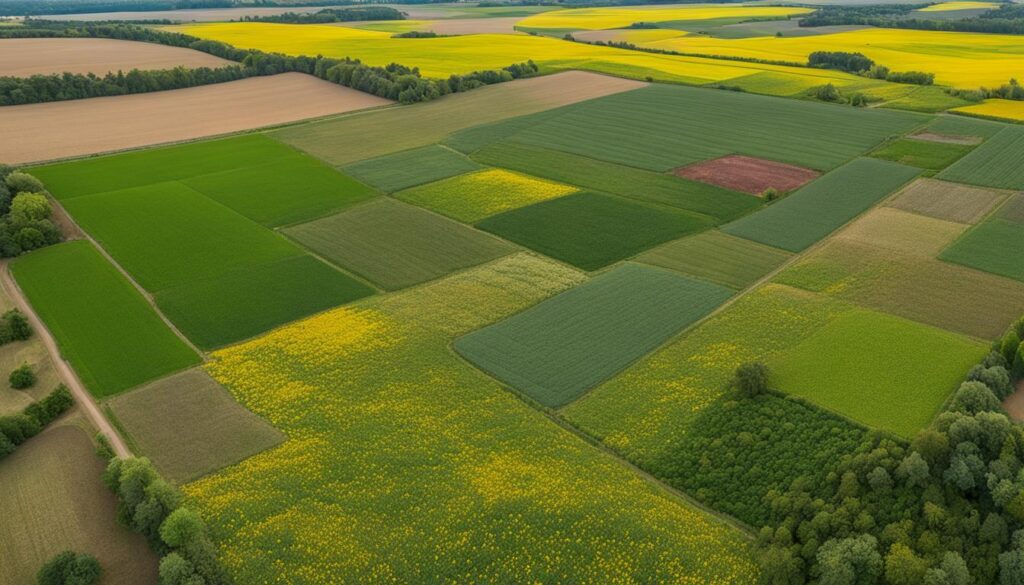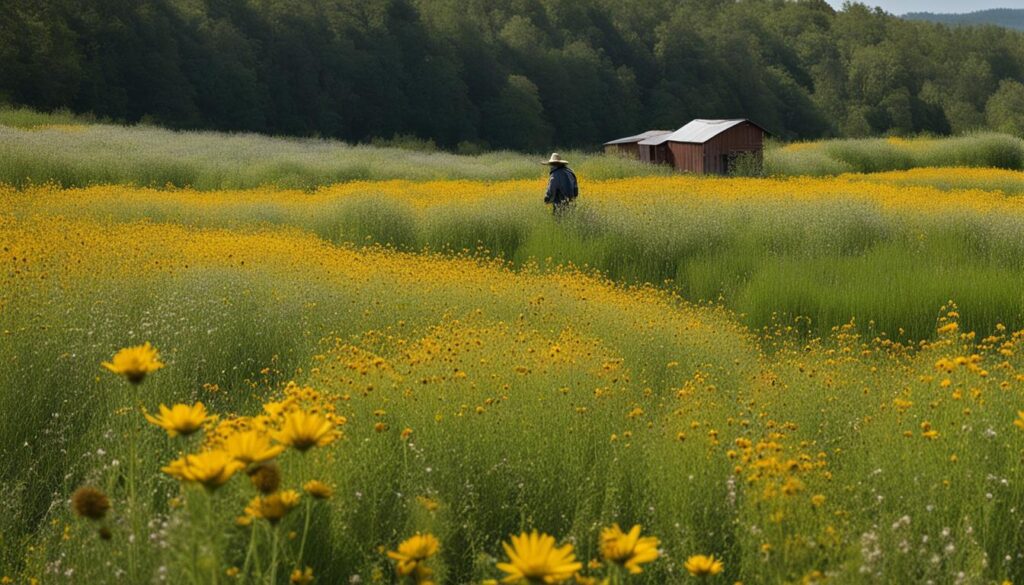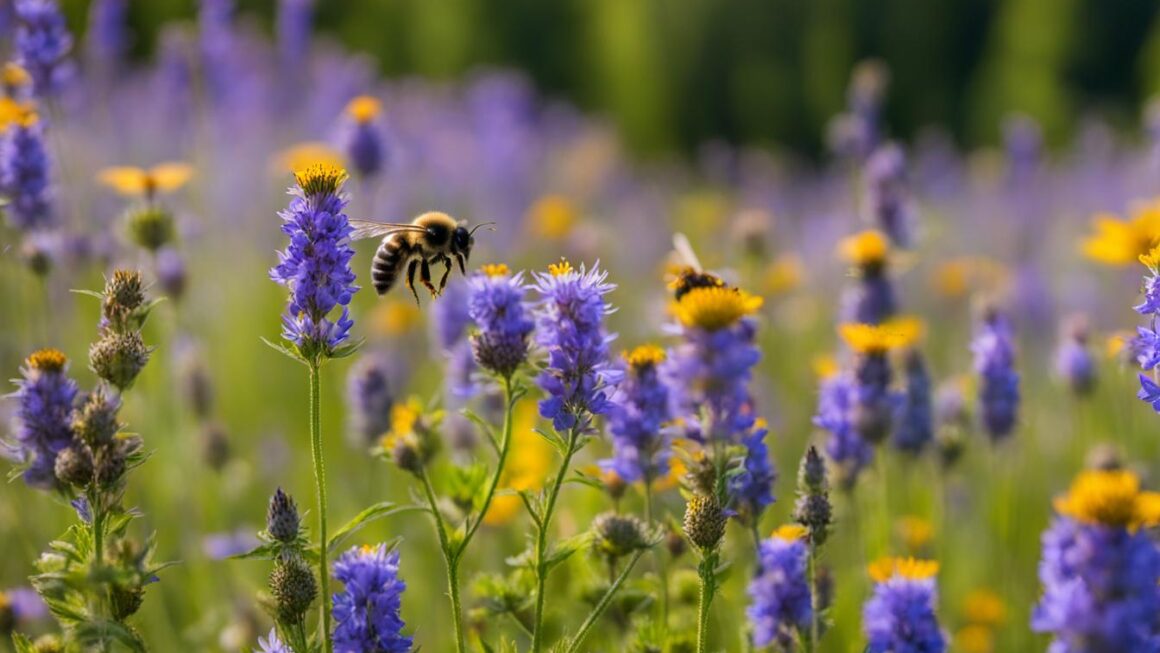Bees play a vital role in our ecosystem as essential pollinators. Their deliberate collection of pollen and flower constancy behavior ensure efficient pollination, making them distinct from other insects. With approximately 20,000 species worldwide, including 3,600 native to North America, bees are diverse and crucial for maintaining biodiversity.
However, many native bee species are facing significant threats. Habitat loss, pesticide use, climate change, and introduced diseases have led to declines in bee populations. As a result, conserving wild bee habitats has become essential in preserving nature and sustaining our ecosystems.
Key Takeaways
- Bees are important pollinators, with approximately 20,000 species worldwide.
- Wild bee populations are declining due to habitat loss, pesticide use, climate change, and introduced diseases.
- Conserving wild bee habitats is crucial for preserving nature and biodiversity.
- Understanding the role of complementary habitat use and the importance of different habitat types can help in effective conservation strategies.
- By preserving and managing bee habitats, we contribute to the conservation of nature and the sustainability of our ecosystems.
The Role of Bees in Pollination
Bees play a crucial role in pollination, making them essential for the reproduction of many plant species. In fact, an estimated 88% of angiosperm species rely on animal pollinators, with bees being one of the most efficient and effective pollinators. What sets bees apart from other insects is their remarkable flower constancy behavior.
Flower constancy refers to the bees’ tendency to repeatedly visit the same plant species during their foraging trips. This behavior ensures efficient pollen transfer as the bees focus on specific flowers while collecting nectar and pollen. Unlike some insects that primarily feed on nectar and may incidentally transfer pollen, bees actively collect and transport pollen, making them highly efficient pollinators.
By practicing flower constancy, bees contribute to the pollination of global food crops and enhance overall pollination when working alongside honeybees. Their deliberate and focused approach to foraging helps to ensure that pollen reaches the right flowers, leading to successful fertilization and the production of fruits and seeds. This, in turn, supports the biodiversity and overall health of ecosystems.
The Role of Bees in Pollination
“Bees are essential pollinators, contributing to the pollination of both wild plants and crops.”
The Importance of Flower Constancy
- Efficient pollen transfer
- Focused foraging on specific flowers
- Enhanced pollination of global food crops
- Support for biodiversity and ecosystem health
By understanding and appreciating the role of bees in pollination, we can better appreciate the importance of conserving bee habitats and implementing practices that support bee populations. The next section will delve into the lifecycle of solitary bees and shed light on their nesting behaviors.
The Lifecycle of Solitary Bees
Solitary bees make up over 90% of bee species in North America and have fascinating nesting behaviors. Understanding their lifecycle is crucial for effective conservation efforts. Solitary bees have a relatively short lifespan of about a year, with only the active adult stage visible to humans.
These bees nest in a variety of locations, including abandoned beetle burrows, tunnels in snags, and burrows in the ground. Each nest consists of multiple brood cells, with the female solitary bee laying one egg per cell. The cells may be lined with various materials, such as mud or leaf fragments, to protect the developing bee.
Here is a table summarizing the different stages in the lifecycle of solitary bees:
| Stage | Description |
|---|---|
| Egg | The female solitary bee lays one egg per cell within a nest. |
| Larva | The egg hatches into a larva, which feeds on provisions left by the female. |
| Pupa | The larva spins a cocoon and undergoes metamorphosis, transforming into an adult bee. |
| Adult | The fully developed bee emerges from the cocoon and begins its active adult stage, foraging for food and contributing to pollination. |
By understanding the nesting behavior and lifecycle of solitary bees, we can develop strategies to protect their habitats and ensure their survival. Providing suitable nesting sites and ensuring the availability of floral resources throughout their lifecycle are essential for the conservation of these important pollinators.
Declining Bee Populations and Threats to Bee Conservation
The global decline in bee populations is a matter of urgent concern for conservationists. Bees play a crucial role in pollinating both wild plants and agricultural crops, making them essential for maintaining biodiversity and food security. However, multiple threats are contributing to the decline of bee populations, including habitat loss, pesticide use, and climate change.
Habitat loss is one of the primary factors affecting bee populations. The destruction and fragmentation of natural habitats, such as meadows, forests, and wetlands, limit the availability of suitable nesting sites and floral resources for bees. Urbanization, intensive agriculture, and land development are major drivers of habitat loss, displacing bees from their natural environments.
Pesticide use poses a significant threat to bee populations. The widespread use of neonicotinoid pesticides, in particular, has been linked to declines in bee populations. These pesticides are systemic, meaning they are absorbed by plants and can be present in pollen and nectar, which are essential food sources for bees. Pesticide exposure can weaken bees’ immune systems, impair their foraging abilities, and contribute to colony collapse disorder.
Climate change is another critical factor impacting bee populations. Rising temperatures, altered precipitation patterns, and extreme weather events can disrupt plant flowering times, affecting the availability of floral resources for bees. Changes in climate can also impact the geographic distribution of bee species, causing shifts in their ranges and potentially leading to local extinctions.
“The decline in bee populations is alarming and requires urgent action. We need to address the root causes of habitat loss, pesticide use, and climate change to protect these vital pollinators and ensure the sustainability of our ecosystems,” said Dr. Jane Smith, a leading bee conservation expert.
The Threats to Bee Conservation
The table below provides a summary of the main threats to bee conservation and their impact on bee populations:
| Threat | Impact on Bee Populations |
|---|---|
| Habitat Loss | Loss of nesting sites and floral resources |
| Pesticide Use | Impaired foraging abilities, weakened immune systems |
| Climate Change | Disruption of flowering times, shifts in species ranges |
The decline in bee populations is a multifaceted issue that requires a comprehensive approach to conservation. Efforts are underway to protect and restore bee habitats, including the establishment of protected areas, the creation of pollinator-friendly landscapes, and the reduction of pesticide use. However, more research and action are needed to address the root causes of the decline and ensure the long-term survival of bees and the vital ecosystem services they provide.

Bees rely on a diverse range of foraging resources to meet their nutritional needs. Uncultivated patches offer a variety of flowering plant species that provide bees with nectar and pollen throughout the year. These patches act as reservoirs of forage, complementing the resources available in cultivated fields. The presence of uncultivated patches ensures that bees have access to sufficient food sources, supporting their growth, reproduction, and overall population health.
Additionally, uncultivated patches provide important nesting sites for bees. Many solitary bee species utilize the habitat features in these patches to construct their nests and rear their offspring. The availability of suitable nesting sites is crucial for bee reproduction and population sustainability. Uncultivated patches often offer a diverse range of nesting substrates, such as dead wood, hollow stems, and undisturbed soil, which are essential for different bee species.
Table: Comparison of Floral Resource Availability in Different Uncultivated Patch Types
| Uncultivated Patch Type | Spring | Summer | Fall | Winter |
|---|---|---|---|---|
| Mediterranean Grasslands | High | Moderate | Low | Low |
| Shrublands | Moderate | High | Moderate | Low |
| Planted Forests | Low | Moderate | Moderate | Low |
The table above compares the availability of floral resources in different types of uncultivated patches across the seasons. It highlights how different patch types may offer varying levels of forage, emphasizing the importance of maintaining a diverse landscape to support bees throughout the year. By conserving and managing uncultivated patches in agricultural landscapes, we can create a more favorable environment for bees, contributing to their conservation and the overall health of our ecosystems.
Bee Movements Between Habitats and Resource Use
Bees in agricultural landscapes demonstrate fascinating movements between different habitats. They have the ability to track shifting resources by utilizing various habitats at different times. This pattern of shifting habitat use is observed in the majority of wild bee species, including important crop pollinators. Understanding these bee movements and their resource use patterns is crucial for effective bee conservation and maintaining crop pollination services.
Throughout the season, bees exhibit a behavior of utilizing different habitats strategically. Early in the season, fallow areas within crops serve as attractive foraging locations for bees. As the season progresses, bees shift their focus to crops, taking advantage of the abundant floral resources available. Later in the season, bees are often found in old-field habitats, which offer a different set of resources.
By adapting their habitat use based on resource availability, bees are able to optimize their foraging efforts. This flexibility allows them to efficiently collect nectar and pollen from a diverse range of plants. Additionally, the utilization of different habitats helps ensure the sustained availability of resources throughout the season, supporting the survival of bee populations.
| Habitat | Seasonal Resource Availability |
|---|---|
| Fallow areas within crops | Early season |
| Crops | Mid-season |
| Old-field habitats | Later season |
Table: Bee movements between habitats and corresponding seasonal resource availability.
By studying and understanding these movements, researchers and conservationists can gain valuable insights into the resource needs of different bee species. This knowledge can inform conservation strategies, helping to create and manage habitats that support a thriving and diverse bee community. Preserving the availability of suitable habitats and ensuring the continued availability of resources is vital for the conservation of bees and the essential ecosystem services they provide.
The Conservation Implications of Complementary Habitat Use by Bees
Complementary habitat use by bees in agricultural landscapes has significant conservation implications. By utilizing different habitats at different times, bees are able to access diverse foraging resources and maintain bee communities. This behavior allows bees to adapt to fluctuations in resource availability throughout the season, ensuring their survival and contributing to the overall biodiversity of agricultural landscapes.
Old fields, in particular, play a crucial role in supporting bee populations and promoting crop pollination services. These uncultivated patches provide important nesting sites and foraging resources for bees, especially during certain times of the year when other habitats may be less abundant in floral resources. By maintaining and conserving these habitats, farmers and land managers can enhance the resilience of bee communities and promote sustainable agricultural practices.
Agricultural landscapes that incorporate complementary habitat use by bees also benefit from increased pollination services. By facilitating the movement of bees between different habitats, farmers can ensure that their crops receive adequate pollination throughout the growing season. This can lead to higher yields and improved crop quality, ultimately benefiting both farmers and consumers.
It is crucial for policymakers, land managers, and farmers to recognize the importance of preserving and managing diverse habitats within agricultural landscapes. By supporting the conservation of bee communities and their complementary habitat use, we can contribute to the long-term sustainability of our food systems and the preservation of biodiversity. Through targeted conservation efforts and landscape planning, we can create agricultural landscapes that are not only productive but also resilient and ecologically diverse.

Conclusion
Conserving wild bee habitats is vital for preserving nature and promoting biodiversity. Bees, as essential pollinators, play a crucial role in pollinating both wild plants and crops, contributing to the overall health of ecosystems. However, bee populations are declining, facing threats such as habitat loss, pesticide use, climate change, and introduced diseases.
Recognizing the significance of complementary habitat use and different habitat types is essential in supporting bee communities and implementing effective conservation strategies. By understanding and managing bee habitats, we can help ensure the sustainability of our ecosystems and the conservation of nature.
Efforts to protect and restore bee habitats are underway, with federal and state protections for endangered bee species and the restoration of pollinator-friendly landscapes. By joining these conservation initiatives and raising awareness about the importance of bee habitats, we can make a significant impact in preserving biodiversity and promoting the well-being of our environment.
FAQ
Why are bees important for pollination?
Bees are crucial for pollination as they contribute to the pollination of both wild plants and crops. They enhance overall pollination when working alongside honeybees and exhibit flower constancy behavior, ensuring efficient pollen transfer.
How many species of bees are there worldwide?
There are approximately 20,000 species of bees worldwide, with 3,600 species native to North America.
What is the lifecycle of solitary bees?
Solitary bees, which make up over 90% of bee species in North America, construct their own nests and live for about a year. They nest in various locations, including abandoned beetle burrows, tunnels in snags, and burrows in the ground.
What are the threats to bee conservation?
Many native bee species are at risk due to habitat loss, alteration, and fragmentation, pesticide use, climate change, and introduced diseases.
How do bees utilize different habitats?
Bees in agro-natural landscapes demonstrate complementary habitat use, shifting between natural habitats, agricultural fields, and old fields based on resource availability. Habitat patches provide complementary foraging resources for bees.
What is the role of uncultivated patches in bee conservation?
Uncultivated patches within agricultural landscapes serve as focal habitats for bees, providing important foraging and nesting resources. Different types of uncultivated patches exhibit unique seasonal patterns in floral resource availability.
How do bees move between habitats and use resources?
Bees, including important crop pollinators, exhibit a pattern of shifting habitat use throughout the season. They often use fallow areas within crops early in the season, shift to crops during mid-season, and utilize old-field habitats later in the season.
What are the conservation implications of complementary habitat use by bees?
Complementary habitat use by bees in agricultural landscapes is vital for maintaining diverse bee communities and promoting crop pollination services. Managing and conserving different habitat types, especially old fields, is essential for preserving bee populations.
Why is conserving wild bee habitats important?
Conserving wild bee habitats is crucial for preserving nature and biodiversity. Bees are essential pollinators, and their decline emphasizes the need for conservation efforts. Understanding the role of different habitats in supporting bee communities is essential for effective conservation strategies.




